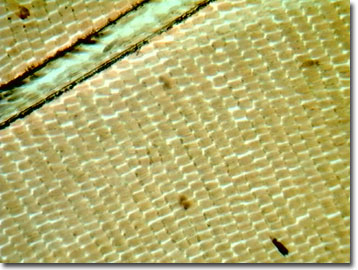Butterfly Wing Scale Digital Image Gallery
Green Swallowtail Butterfly
The green swallowtail butterfly is a tropical native of the highland forests of sub-Saharan Africa, but is reared in captivity in butterfly conservatories across North America and Europe. Unusual in the animal kingdom, these lepidopterans exhibit intraspecific sexual mimicry, some female members of a population imitating male morphology.

The purpose of the female green swallowtail male-like morphs is ambiguous and debated among scientists. Some believe they may achieve a fitness advantage over other females by avoiding high levels of harassment by males seeking to mate, but the evolutionary explanation is still controversial since male-morph females do not suffer from less frequent successful mating than other green swallowtail females. Intraspecific sexual mimicry is not an exclusive trait of the green swallowtail butterfly, but can be observed in other insects, such as some damselfly species.
True blue is a relatively rare color in nature, but is surprisingly present in the green swallowtail butterfly. The color blue in other butterflies, such as the blue morpho, comes from structural designs in the wing scale arrangement. Light interference, reflection, and refraction create a blue hue, not actual color pigments. The green swallowtail butterfly, however, features a true blue pigment, which combines with a yellow pigment to create the beautiful green coloration characteristic of the species.
Similar to many of the butterfly species in the family Papilionidae, green swallowtail larvae feature bright orange osmeteria, which are normally hidden behind the heads of the caterpillars. When a predator is detected, the caterpillar rears up on its prolegs, swells its thorax, and inflates its osmeteria. False thoracic eyespots and a semblance of a forked tongue help the larva project the appearance of a snake about to strike. Each osmeterium emits a chemical substance that further helps to deter predation. When danger has passed, the osmeteria are retracted and the caterpillar resumes its normal activities.
Scientifically known as Papilio phorcas, the green swallowtail butterfly is represented by seven Central African subspecies. Members of the species are considered very weak fliers and can be frequently found nectaring on low-growing flowers or gliding close to the ground. Such characteristics make the green swallowtail particularly susceptible to over-harvesting by butterfly collectors. In fact, some of the unique populations and subspecies are considered endangered in their native countries.
Contributing Authors
Cynthia D. Kelly, Shannon H. Neaves, Laurence D. Zuckerman, and Michael W. Davidson - National High Magnetic Field Laboratory, 1800 East Paul Dirac Dr., The Florida State University, Tallahassee, Florida, 32310.
BACK TO THE BUTTERFLY WING SCALE IMAGE GALLERY
BACK TO THE DIGITAL IMAGE GALLERIES
Questions or comments? Send us an email.
© 1995-2025 by Michael W. Davidson and The Florida State University. All Rights Reserved. No images, graphics, software, scripts, or applets may be reproduced or used in any manner without permission from the copyright holders. Use of this website means you agree to all of the Legal Terms and Conditions set forth by the owners.
This website is maintained by our
Graphics & Web Programming Team
in collaboration with Optical Microscopy at the
National High Magnetic Field Laboratory.
Last Modification Friday, Nov 13, 2015 at 01:19 PM
Access Count Since January 21, 2003: 10059
Visit the website of our partner in introductory microscopy education:
|
|
